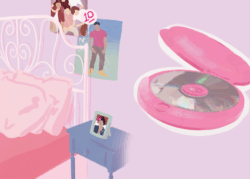It was my second day shopping for school supplies in St. Petersburg. I thumbed the thin, flimsy pages and then turned the notebook over on its spine, and inspected the front cover. My face fell in disappointment as I saw the same old image as in all my previous experiences in Russia: a silhouette of a single horse lined in glitter.
Living in Russia over the past summer has taught me to expect less when it comes to certain products. When shopping for school supplies, for example, I reluctantly accepted that all my stationery was designed with children in mind. I learned to tolerate a corral of kittens on the front cover of my notebook, or even a collection of monster trucks coated in graffiti. I found that the Russian equivalent of a solid-color cover is the image of a horse. I also came to understand that the quality of household products in the United States is simply better.
Americans are lucky because the entire world caters to our economy, the largest and most profitable in the world, but we are able to avoid this truth easily if we never experience the quality of life in another nation firsthand. I became more aware of America’s impressive claim to the international market once I embarked on a summer-long, multi-country quest for a miniature clothing steamer. I traveled between two eastern European countries before I concluded that neither the Russians nor the Latvians are in need of a steamer. I eventually found the elusive product in the most American-friendly place in St. Petersburg—a five-story shopping mall called the “Galeria.”
My hunt for school supplies was the same narrative. My friend and I spent two whole days searching for notebooks. We decided to compromise on style the second day, but remained unwilling to negotiate on functionality. Only later did we discover that the overwhelming majority of notebooks in Russia consist of graph paper instead of lined paper. I found fewer than five notebooks in all of St. Petersburg that preferred the apparently Western model that is lined paper. It was childish and difficult to explain, but this small detail prompted real frustration in both of us. We confronted culture shock in the least likely of areas.
We looked to the past in an attempt to direct our anger at the source. We cited back-to-school shopping experiences in the States from as young as the age of seven. Our memories were not unalike: Mom and Dad strolling the aisles of Staples, only to dodge other eager parents, gripping at a shopping cart full of brand new, polished school supplies. These memories also triggered an inexplicable desire for Five-star, spiral-bound, heavy-lined-paper with a solid-color cover. Another question infiltrated our thoughts—why were our tastes so specific?
Once we extended our self-reflection to our experience in Russia, we were able to identify the hard-hitting truths about American culture and the consumerism deeply ingrained within it. We realized our disappointment in Russian school supplies stemmed from the expectation instilled within us by our American upbringing. Our original frustration over lined paper smoothly transitioned into a greater discussion of this commercialization seen in the United States. Back-to-school shopping, like Valentine’s Day to wedding celebrations, is sexed up and twisted into something far beyond ballpoint pens. It is an annual event that has become a staple in American culture but holds no real value or purpose.
Our recognition of our entitlement to lined paper left us feeling ashamed. We not only recognized the privilege-soaked pettiness in our preference but also began to think of the annual event in the context of American society. Back-to-school shopping is a measure of the socioeconomic divide in our country—some children are lucky enough to participate in this event while others are marginalized for their economic inability to do so. It took the same experience in another country to expose this unpleasant reality about an otherwise unexciting tradition.
I’m not criticizing Americans for their expectations of quality in their products, nor am I labeling Russians as backwards for all their glitter-lined horses. It is impossible and unproductive to measure one culture against another. We were surprised, but ultimately happy that we were able to say so much about a difference between lined paper. I just wish I was able to buy the graph paper.




